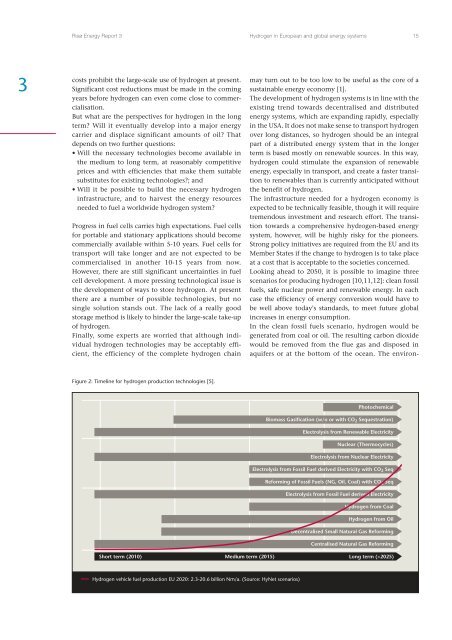14Risø Energy Report 3<strong>Hydrogen</strong> in European <strong>and</strong> global energy systems3European Commission supports the European <strong>Hydrogen</strong>Network (HyNet), which was established in 1999 withthe main objective of bringing together Europeanhydrogen stakeholders from industry, research institutions<strong>and</strong> governments. Thus the European Commissionis focusing more <strong>and</strong> more on the likelihood of a futurehydrogen economy.The IEA has also taken an interest in hydrogen <strong>and</strong> fuelcells, although to a lesser extent than the EU. The IEA hasset up <strong>Hydrogen</strong> Program Implementing Agreements,whose main purpose is to co-ordinate ongoing R&Dbetween IEA member countries. These are normally setup on a cost-shared basis <strong>and</strong> are open to any IEAmember, both OECD <strong>and</strong> non-OECD, who wishes toparticipate. Implementation agreements exist for bothhydrogen <strong>and</strong> fuel cells.Long-term visions for the hydrogen societyLong-term challenges, such as climate change, securityof energy supply <strong>and</strong> depletion of oil resources, requirelong-term solutions. Many politicians <strong>and</strong> scientistsbelieve that a combination of fuel cells <strong>and</strong> hydrogeninfrastructure will be a practical way to create an efficient,clean <strong>and</strong> sustainable energy system within thenext 20-40 years.One of the most ambitious recent initiatives is the InternationalPartnership for the <strong>Hydrogen</strong> Economy (IPHE,above). Its main goal is “to serve as a mechanism toorganize <strong>and</strong> implement effective, efficient <strong>and</strong> focusedinternational research, development, demonstration <strong>and</strong>commercial utilization activities related to hydrogen <strong>and</strong>fuel cell technologies. The IPHE also provides a forum foradvancing policies, <strong>and</strong> common codes <strong>and</strong> st<strong>and</strong>ardsthat can accelerate the cost-effective transition to aglobal hydrogen economy to enhance energy security<strong>and</strong> environmental protection” [8].The EU High Level Group for <strong>Hydrogen</strong> <strong>and</strong> Fuel Cells(HLG) has also looked into the possibilities of creating ahydrogen economy in the long term. One of the HLG'sconclusions is [4]:“…hydrogen <strong>and</strong> electricity together represent one ofthe most promising ways to realise sustainable energy,whilst fuel cells provide the most efficient conversiondevice for converting hydrogen, <strong>and</strong> possibly other fuels,into electricity. <strong>Hydrogen</strong> <strong>and</strong> fuel cells open the way tointegrated 'open energy systems' that simultaneouslyaddress all of the major energy <strong>and</strong> environmental challenges,<strong>and</strong> have the flexibility to adapt to the diverse<strong>and</strong> intermittent renewable energy sources that will beavailable in the Europe of 2030”.Some highlights from the HLG report include:• <strong>Hydrogen</strong> opens up the possibility of using a broadrange of primary energy sources, including fossil fuels,nuclear <strong>and</strong> renewable energy.• The combination of the electricity grid <strong>and</strong> a hydrogensystem, including hydrogen storage, provides flexibilityin balancing conventional <strong>and</strong> intermittentrenewable energy sources, while hydrogen as an energycarrier makes new energy sources available to the transportsector.• <strong>Hydrogen</strong> produced from carbon-free or carbonneutralenergy sources can provide significant reductionsin carbon dioxide emissions by replacing fossilenergy sources. This is especially relevant to the transportsector.To support the development of a hydrogen economy, thepartners of the European <strong>Hydrogen</strong> Energy ThematicNetwork (HyNet) have developed a European <strong>Hydrogen</strong>Energy Roadmap. The main conclusions from this roadmapare [5]:<strong>Hydrogen</strong> production: In the short <strong>and</strong> medium term, technologiesthat are already commercially available – steamreforming <strong>and</strong> electrolysis – will be vital for the productionof hydrogen, although at a higher cost than conventionalfuels. In the longer term, hydrogen could beproduced at costs that would make it competitive withdiesel <strong>and</strong> gasoline, based on current predictions foradvances in technology <strong>and</strong> economies of scale in manufacturing.<strong>Hydrogen</strong> infrastructure: The costs of transport, storage<strong>and</strong> refuelling facilities are key obstacles to the hydrogeneconomy. Investment costs <strong>and</strong> associated risks are high,so a hydrogen infrastructure will require significantcommitment from industry, governments <strong>and</strong> otherstakeholders. <strong>Hydrogen</strong> storage is an essential technologythat has the potential to become a bottleneck.Extensive R&D is required to develop innovative storagesolutions.Dem<strong>and</strong> for hydrogen: Small portable applications forhydrogen are expected to enter the market within thenext 2-3 years, <strong>and</strong> these will help pave the way for largerhydrogen users. Stationary fuel cells, mostly based onnatural gas, are expected to be commercialised before2010. Transport applications will be the main driver forthe development of hydrogen systems, but this marketwill not take off before 2010-2015.Legal requirements, regulations <strong>and</strong> st<strong>and</strong>ards need to be inplace in order to facilitate hydrogen development.Socio-economic issues <strong>and</strong> government policies are important.Governments have to stimulate R&D <strong>and</strong> largescaledemonstration projects, while long-term policysupport is needed if hydrogen is to become commerciallysuccessful in a reasonable timescale.Figure 2 shows a possible timeline for the developmentof hydrogen production technologies. Short-termhydrogen development will rely mainly on conventionalfossil fuels, whilst in the very long term technologiescould include photo-biological or photo-electrochemicalconversion processes <strong>and</strong> thermonuclear conversioncycles. It is clear that a number of initiatives are underway to develop hydrogen systems. A good deal ofresearch is going on, <strong>and</strong> a number of demonstrationplants have already been established. Nevertheless, high
Risø Energy Report 3<strong>Hydrogen</strong> in European <strong>and</strong> global energy systems 153costs prohibit the large-scale use of hydrogen at present.Significant cost reductions must be made in the comingyears before hydrogen can even come close to commercialisation.But what are the perspectives for hydrogen in the longterm? Will it eventually develop into a major energycarrier <strong>and</strong> displace significant amounts of oil? Thatdepends on two further questions:• Will the necessary technologies become available inthe medium to long term, at reasonably competitiveprices <strong>and</strong> with efficiencies that make them suitablesubstitutes for existing technologies?; <strong>and</strong>• Will it be possible to build the necessary hydrogeninfrastructure, <strong>and</strong> to harvest the energy resourcesneeded to fuel a worldwide hydrogen system?Progress in fuel cells carries high expectations. Fuel cellsfor portable <strong>and</strong> stationary applications should becomecommercially available within 5-10 years. Fuel cells fortransport will take longer <strong>and</strong> are not expected to becommercialised in another 10-15 years from now.However, there are still significant uncertainties in fuelcell development. A more pressing technological issue isthe development of ways to store hydrogen. At presentthere are a number of possible technologies, but nosingle solution st<strong>and</strong>s out. The lack of a really goodstorage method is likely to hinder the large-scale take-upof hydrogen.Finally, some experts are worried that although individualhydrogen technologies may be acceptably efficient,the efficiency of the complete hydrogen chainmay turn out to be too low to be useful as the core of asustainable energy economy [1].The development of hydrogen systems is in line with theexisting trend towards decentralised <strong>and</strong> distributedenergy systems, which are exp<strong>and</strong>ing rapidly, especiallyin the USA. It does not make sense to transport hydrogenover long distances, so hydrogen should be an integralpart of a distributed energy system that in the longerterm is based mostly on renewable sources. In this way,hydrogen could stimulate the expansion of renewableenergy, especially in transport, <strong>and</strong> create a faster transitionto renewables than is currently anticipated withoutthe benefit of hydrogen.The infrastructure needed for a hydrogen economy isexpected to be technically feasible, though it will requiretremendous investment <strong>and</strong> research effort. The transitiontowards a comprehensive hydrogen-based energysystem, however, will be highly risky for the pioneers.Strong policy initiatives are required from the EU <strong>and</strong> <strong>its</strong>Member States if the change to hydrogen is to take placeat a cost that is acceptable to the societies concerned.Looking ahead to 2050, it is possible to imagine threescenarios for producing hydrogen [10,11,12]: clean fossilfuels, safe nuclear power <strong>and</strong> renewable energy. In eachcase the efficiency of energy conversion would have tobe well above today's st<strong>and</strong>ards, to meet future globalincreases in energy consumption.In the clean fossil fuels scenario, hydrogen would begenerated from coal or oil. The resulting carbon dioxidewould be removed from the flue gas <strong>and</strong> disposed inaquifers or at the bottom of the ocean. The environ-Figure 2: Timeline for hydrogen production technologies [5].PhotochemicalBiomass Gasification (w/o or with CO 2 Sequestration)Electrolysis from Renewable ElectricityNuclear (Thermocycles)Electrolysis from Nuclear ElectricityElectrolysis from Fossil Fuel derived Electricity with CO 2 SeqReforming of Fossil Fuels (NG, Oil, Coal) with CO 2 SeqElectrolysis from Fossil Fuel derived Electricity<strong>Hydrogen</strong> from Coal<strong>Hydrogen</strong> from OilDecentralised Small Natural Gas ReformingCentralised Natural Gas ReformingShort term (2010)Medium term (2015)Long term (>2025)■<strong>Hydrogen</strong> vehicle fuel production EU 2020: 2.3-20.6 billion Nm/a. (Source: HyNet scenarios)
















